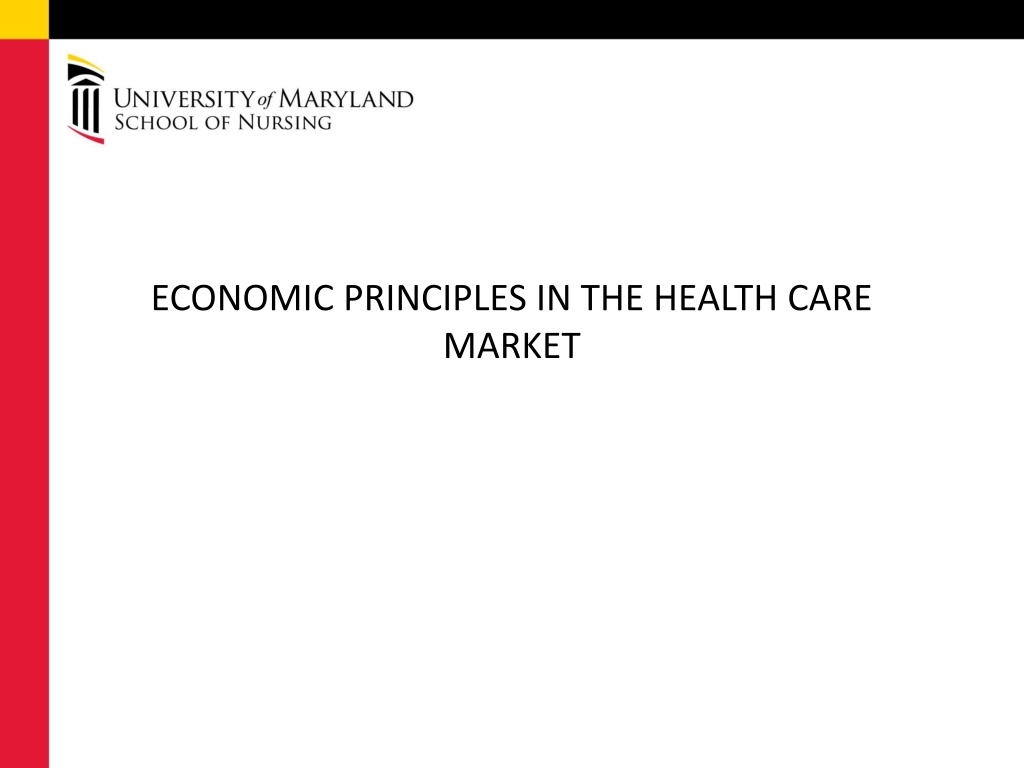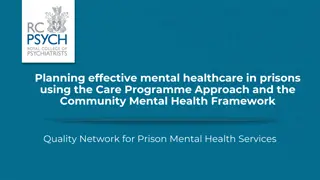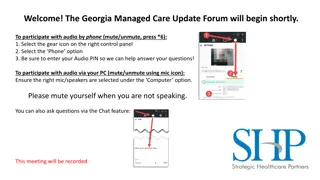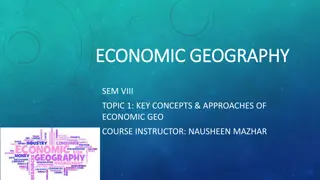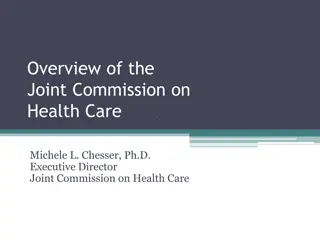Economic Principles in Health Care Market
The study of allocating scarce resources in the health care market involves evaluating how health care is produced, distributed, and consumed. Economics provides a framework for decision-making, addressing questions on production, distribution, measurement of output, and resource allocation. The health care market comprises suppliers, purchasers, payors, and providers, with ultimate payors being government, employers, and individuals. Understanding the roles and interactions of payors, providers, and suppliers is essential in this complex market.
Download Presentation

Please find below an Image/Link to download the presentation.
The content on the website is provided AS IS for your information and personal use only. It may not be sold, licensed, or shared on other websites without obtaining consent from the author.If you encounter any issues during the download, it is possible that the publisher has removed the file from their server.
You are allowed to download the files provided on this website for personal or commercial use, subject to the condition that they are used lawfully. All files are the property of their respective owners.
The content on the website is provided AS IS for your information and personal use only. It may not be sold, licensed, or shared on other websites without obtaining consent from the author.
E N D
Presentation Transcript
ECONOMICS The study of allocating scarce resources among competing needs Allocating resources refers to how goods or services are produced and distributed to consumers Resources are scare relative to needs and wants Resources have alternative uses People have different wants and place different values on those wants
ECONOMICS PROVIDES AN EVALUATIVE FRAMEWORK FOR MAKING HEALTH CARE DECISIONS What kind of health care will be produced? How will health care be produced and channeled to consumers? How much health care will be produced? Who gets the health care produced? How will output be measured? Treatments performed vs. outcomes obtained vs. better quality of life? Who will produce health care? Private office practice vs. retail clinic (e.g. Minute Clinic) vs. website? How much will be produced, and will the output be determined by need vs. want?
HEALTH CARE MARKET A GROUP OF SUPPLIERS AND PURCHASERS IN TOUCH WITH EACH OTHER IN ORDER TO BUY AND SELL GOODS AND SERVICES
PAYORS INDEMNITY INSURANCE HMOs SPECIALTY MANAGED CARE These payors negotiate price directly with the suppliers of health care and are the actual buyers of health care
ULTIMATE PAYORS GOVERNMENT EMPLOYERS INDIVIDUALS These are the ultimate funders of health care, supplying the money used by the frontline payors to buy health care
PROVIDERS PHYSICIANS HOSPITALS HOME HEALTH CARE NURSING HOMES OTHER HEALTH CARE AGENCIES These are the frontline suppliers of health care. They are dependent on an authorized prescriber (e.g. physician, Advanced Practice Registered Nurse) to make the decision that triggers the purchase of health care by the payor.
SUPPLIERS DRUG MANUFACTURERS DURABLE MEDICAL EQUIPMENT LABORATORIES DIAGNOSTIC IMAGING MEDICAL SUPPLIES These supply health care goods and services to the frontline providers of health care. They are dependent on both the authorized prescriber s decision and the frontline provider s selection to have their goods and services sold to the payors of health care.
INTERACTIONS IN THE HEALTH CARE MARKET INDIVIDUALS GOVERNMENT EMPLOYERS ULTIMATE PAYORS SPECIALTY MANAGED CARE HMOS PAYORS INDEMNITY INSURANCE HOME HEALTH PROVIDERS DOCTORS NURSING HOMES HOSPITALS OTHERS SUPPLIERS PRODUCTS LABS DRUGS EQUIPMENT OTHERS
WHERE IS THE PATIENT? LARGELY ABSENT FROM THE PURCHASING DECISION AND PRICE- INSULATED TO ITS COST
SUPPLY Amount of a commodity sellers offer at various prices Supply is affected by: State of technology used to produce Price of resources used to produce (labor, materials) Number of suppliers Future expectations re: supply e.g. competitor coming out with new model Price of related commodities compliments vs. substitutes COMPLIMENT goods or services used to augment or expand reach of the primary provider. A Certified Nursing Assistant is used to expand the care giving capacity of Registered Nurses. SUBSTITUTE goods or services that take the place of the primary provider. An Advanced Practice Registered Nurse may be a substitute for a physician provider.
DEMAND Amount of a commodity sellers offer at various prices Demand is affected by: Price of the commodity Availability of commodity (e.g. specialty services in rural areas) Preferences of consumers (and in health care, health insurers) Number of consumers in market (e.g. geriatric services as baby boomers age) Income of consumers (to pay directly or through health insurance premiums) Price of related commodities (compliments, substitutes) Expectations re: future prices or income
COST Should cover expenses to produce the commodity May exceed expenses to produce commodity because: Commodity is seen as essential (e.g. Hepatitis C treatment) There are no available compliments or substitutes (e.g. patents on drugs or scope of practice restrictions on providers through licensure laws) Consumers are insulated from total cost by insurance
OVERALL COST = PRICE X QUANTITY For US total health care expenses, this is an extremely important concept. Health care is a commodity most US residents use at some point in time. When there is a need to purchase, it is not considered a discretionary expense. Even if the unit price of a service (commodity) is low, use by high numbers of people drives up overall cost. As nurses, we are taught prevention is better than treatment. That is usually true when looking at costs and outcome for the individual patient. However, the cost of a more expensive preventive commodity (e.g. screening mammography) when used by a large number of consumers most of whom would never develop the disease can exceed the cost of treating the disease when it develops. That is one reason why the US Preventative Services Task Force issues guidelines for screening based on risk of occurrence of the disease and ability to catch the disease early enough for successful treatment.
OPPORTUNITY COSTS Money available to purchase commodities is not infinite. Opportunity Costs are the benefits that must be sacrificed (foregone) as a result of choosing an alternative. What is given up to gain something else. What is the opportunity lost. Stakeholders exert influence in any health policy debate over how resources should be allocated, creating winners and losers in terms of the health care offered (the alternative chosen). ACUTE CARE & HIGH TECHNOLOGY VS. PRIMARY CARE & PREVENTION
EQUILIBRIUM THE POINT AT WHICH A COMMODITY SUPPLIED EQUALS QUANTITY DEMANDED. THE POINT IS ALWAYS CHANGING.
COMPETITION In order to have a competitive and open market, certain market features must be present. Consider each of these features as they pertain to the health care market. Large numbers of buyers and sellers It is easy to enter the health care market as a consumer. Are there large numbers of sellers? Are they distributed among the population based on health need or ability of the consumer to pay? No collusion among buyers or sellers to fix prices or quantities The health care industry is not without anti-trust litigation over collusion to fix prices or quantities (see readings). Do any health professionals education programs limit slots for students, resulting in a limited number of provider graduates entering the market? What would be the effect on prices for their services?
COMPETITION (CONT) Free and easy entry into market by new buyers and sellers Entry into the market as a buyer starts with birth and continues to death. Is it easy to enter the market as a seller? Consider health professionals education costs, and the cost to construct, staff and supply a health care facility. No government restraints on prices or quantities - Health professionals licensure laws, FDA regulations for drugs and devices, and facility construction restrictions such as CON affect quantity and ultimately price of services offered. Even the government s ability to negotiate drug prices in its role of payor under the Medicare prescription drug program has been blocked by stakeholders influence in Congress. Buyers and sellers have accurate information about price and quality This is one of the key barriers consumers have to even decide if they have a real need for health care services and what the service should really cost. Contrast the amount of information consumers are able to obtain when car shopping with the amount and quality of information they can obtain when determining if they need, and from whom they should purchase, health care services.
PRICING SERVICES COST BASED Direct expenses (salaries, supplies, equipment), indirect expenses (support or ancillary services), debt service, depreciation of equipment and funding of replacement costs, and uncollectable accounts leading to cost shifting to paying customers are calculations used to determine cost based pricing of health care services. COMPETITION BASED Marketplace influencing price, this is often seen where there is an oversupply of a commodity relative to demand. Competitors try to undercut each other on price (e.g. listen to the different advertisements for laser eye surgery). DEMAND BASED Price is inflated when supply is low relative to demand and ability to pay. In certain areas of Maryland, the price of psychiatric services is affected by the number of psychiatrists relative to demand for their services, as well as the ability of these providers to refuse to take health insurance reimbursement because the consumers in their market can afford to pay out of pocket.
ROLE OF GOVERNMENT ALLOCATION Government acts to spur or inhibit development of health care resources. Medicare funding of Graduate Medical Education (GME) residency programs, HHS Nurse Traineeships, and state issued CONs are types of allocation controls. REDISTRIBUTION Government action to transfer income from one group to another. Taxes, subsidies, vouchers, Medicaid, WIC, food stamps are examples of government redistribution of income from one group to another. STABILIZATION Government action to reduce dramatic changes in output (supply), employment, cost and quantity. Why is that important in healthcare? What would happen to the supply of providers if Medicare or Medicaid reimbursement fell too low?
STABILIZING COST CONTROLS TAKEN BY PUBLIC AND PRIVATE SECTORS FINANCING Increasing or restricting the flow of money into the system through taxes (government action) or premiums collected (private sector). More or less money available for a payor means more or less money can flow as reimbursement to a provider. REIMBURSEMENT Payor caps on fees paid to providers can contain costs, but it can also cause providers to refuse to participate in the payors health plans. Patients covered by those health plans may be unable to find a provider willing to treat them, forcing the payor to raise the cap. The economic dynamic of a fluctuating equilibrium is evident when reimbursement controls are applied. UTILIZATION Instead of restricting reimbursement, the payor (public or private) restricts access to or duration of services as a means of cost control. Reimbursement for preventive services or treatment services such as physical therapy is controlled by the utilization review process. The economic principle of overall cost = price x quantity is the operational dynamic of utilization control.
